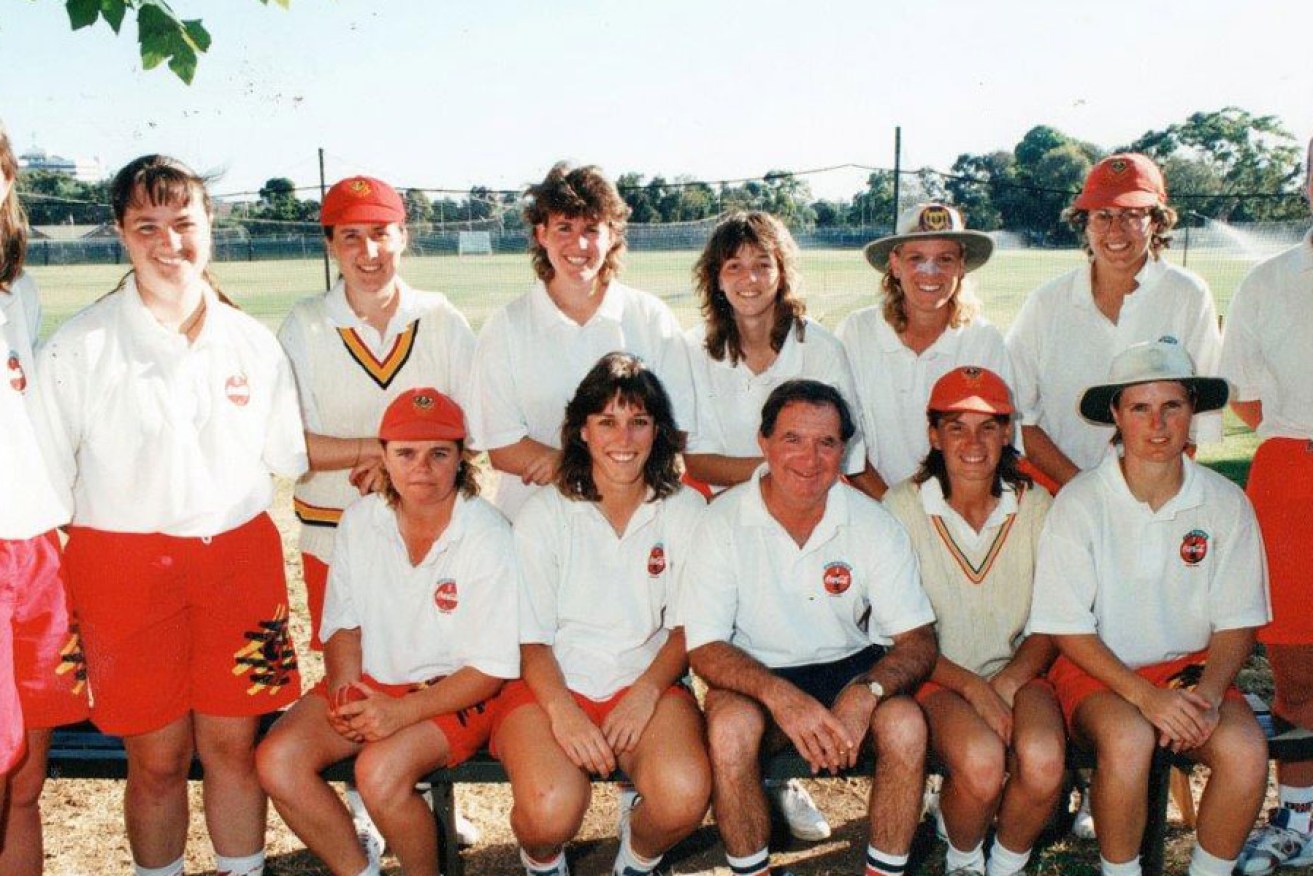The golden era of SA women’s cricket

The victorious South Australia cricket team from 1994-95, with coach Denis Brien.
With Denis Brien as the state coach and Yorke Peninsula product Andrea McCauley as the on-field general, South Australia women’s cricket had its first and, to this point, only golden era, two decades ago.
This month marks the 20th anniversary of that special summer, where the South Australian’s were favourites to win their third title in four years – and delivered in emphatic style.
There were reminders of that dominant era on Sundy, when this year’s Women’s National Cricket League final was played in Sydney. The two opposing coaches, McCauley (Scorpions) and Joanne Broadbent (NSW Blues), were the SA team’s captain and vice-captain back in January 1995.
Before Brien took over the coaching role in the late 1980s, SA had won just two titles – a first in 1951-52 and the other in 1979-80.
Since he finished up in the role, nothing new has been added to the trophy case.
An astute coach, Brien ran a professional program even by today’s standards.
Having contacts at the SACA, he was able to gain access to turf wickets on Adelaide number 2 ground for one night per week and to use that ground for fielding on Friday nights at no charge, thanks to long-time curator Les Burdett.
“Back then the selection of a squad of 13 was made by holding net trials,” Brien explained.
“This was difficult at first as fewer than 20 players would be available comprising two groups – those with national aspirations and the few who wanted to take a cricket holiday.
“After selection the approach was to work on technical skills and gradually build self-confidence and mental toughness.
“A program was set which was divided into to two four-week macro-cycles with each being dissected into weekly micro-cycles of the macro cycle with the major intensity in the third week.”
Part of Brien’s strategy was to hold one or two games against men’s teams – ideally a state under-age team, or a district club’s under-17s side.
The strategy for the championship fortnight was finely calibrated.
“As the championship was held over two weeks with a round robin of one-day matches followed by two-day knock out finals, the goal was to have the players peak at semi-final time and achieve a second or third place spot to avoid the top team in the semi and thus polish the skills for the Grand Final.
“However the experience of the players by 1994-95 saw them finish in top spot.
“The key to the success was undoubtedly the astute leadership of Andrea McCauley.
“I rank her alongside Ian Chappell, Darren Lehmann and David Hookes as the best captains I’ve been associated with.”
In this golden period from 1991-92 to 1994-95 South Australia won three national crowns in four years, with two of them played interstate (Orange in ’92 and Canberra in ’94).
Skipper McCauley confirmed the SA team was pretty powerful combination in January 1995.
“Not often does a South Australia team in any sport go to a national carnival as favourites,” she said.
“It was a power packed combination and ‘Rowly’ (Karen Rolton) was on one of her first tours with us.
“There were seven of us – Joanne Broadbent, Lee-anne Hunter, Tunde Juhasz, Karen Rolton, Isabelle Tsakiris, Caroline Ward and myself – that had or would represent Australian during that period.
“Melissa Cann and Allyson Kenelley were also in Australian squads.”
The 1994-95 carnival
Denis Brien’s troops won their opening round robin game against Queensland after a brilliant 82 from Caroline Ward, but lost their round-two fixture against NSW by four wickets.
Rebounding quickly, on the back of an unbeaten 115 from Lee-anne Hunter, they thrashed the ACT by 134 runs in round three, before clinching a hard fought two-wicket win over Western Australia.
In the final group-stage game, against their future grand final opponent, the bowlers were frugal, keeping the Victorian’s to 121. Top order chased down the runs for the loss of a single wicket in the final group-stage game. Hunter again led the way with an unconquered half century and Melissa Cann was run out, when she was on top of the bowling and had made 37.
Playing WA in the semi final, SA batted first and had many contributors in an impressive total of 299. Hunter at the top of the order again produced, this time scoring a handsome 79, while Ward made a handy 33. In the middle order keeper-batsman Tunde Juharz produced an important 50 and Joanne Broadbent compiled an impressive 70.
Off -spinner Carolyn Dittmar claimed 3/12 as WA was dismissed for 183, while teenager Karen Rolton was also a multiple wicket taker finishing with 2/35.
Day one of the final was washed out, forcing the title to be decided over a one-day fixture.
Victoria batted first and posted a respectable score of 7/154, but a then 19-year-old Rolton proved she was going to be a star of the future with a brilliant and unbeaten 68 to ensure the South Aussies won the title with six wickets to spare, bringing home the prized Ruth Preddey Cup.
Scoreboards – Ruth Preddey Cup
Rd 1 – SA 5/185 (Ward 82) defeated Queensland 159 (Broadbent 2/22, Rolton 2/13)
Rd 2 – SA 7/148 (Hunter 33, McCauley 31) lost to NSW 6/150 (Hunter 2/26)
Rd 3 – SA 3/215 (Hunter 115*) defeated ACT 81 (Cann 3/13, Rolton 2/9, Dittmar 2/11)
Rd 4 – WA 9/140 (Broadbent 2/15, Rolton 3/21) lost to SA 8/141 (Kennelley 41, Ward 31)
Rd 5 – Vic 121 (Broadbent 2/29, Rolton 2/23, Cann 2/13) lost to SA 1/122 (Hunter 54 *, Cann 37ro)
Semi Final – SA 299 (Hunter 79, Ward 33, Juharz 50, Broadbent 70) defeated WA 183 (Dittmar 3/12, Rolton 2/35)
Grand Final – Vic 7/154 (Cann 2/18) lost to SA 4/155 (Rolton 68*)




